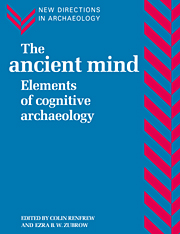Book contents
- Frontmatter
- Contents
- List of figures
- List of tables
- List of contributors
- Preface
- PART I INTRODUCTION
- PART II THE INTERDISCIPLINARY UNDERPINNING
- 2 Interpretation and testability in theories about prehistoric thinking
- 3 Archaeology and cognitive science
- 4 From domain specific to generalized intelligence: a cognitive interpretation of the Middle/Upper Palaeolithic transition
- 5 Are images animated? The psychology of statues in Ancient Greece
- PART III APPROACHES TO CULT PRACTICE AND TRANSCENDENTAL BELIEF SYSTEMS
- PART IV PREHISTORIC CONCEPTIONS OF SPACE AND TIME
- PART V THE MATERIAL BASIS OF COGNITIVE INFERENCE: TECHNOLOGY
- PART VI THE MATERIAL BASIS OF COGNITIVE INFERENCE: WRITING SYSTEMS
- PART VII CONCLUSION
- Index
2 - Interpretation and testability in theories about prehistoric thinking
Published online by Cambridge University Press: 03 December 2009
- Frontmatter
- Contents
- List of figures
- List of tables
- List of contributors
- Preface
- PART I INTRODUCTION
- PART II THE INTERDISCIPLINARY UNDERPINNING
- 2 Interpretation and testability in theories about prehistoric thinking
- 3 Archaeology and cognitive science
- 4 From domain specific to generalized intelligence: a cognitive interpretation of the Middle/Upper Palaeolithic transition
- 5 Are images animated? The psychology of statues in Ancient Greece
- PART III APPROACHES TO CULT PRACTICE AND TRANSCENDENTAL BELIEF SYSTEMS
- PART IV PREHISTORIC CONCEPTIONS OF SPACE AND TIME
- PART V THE MATERIAL BASIS OF COGNITIVE INFERENCE: TECHNOLOGY
- PART VI THE MATERIAL BASIS OF COGNITIVE INFERENCE: WRITING SYSTEMS
- PART VII CONCLUSION
- Index
Summary
Exploration of the prehistoric mind has moved to the forefront of archaeological interest. The question is not whether there is a cognitive revolution but how empirical investigations should proceed and what method(s), if any, should guide theory structure. This paper concentrates on the latter: on guidelines for building and assessing theories about prehistoric thinking. The central point is that archaeologists should aim at constructing testable theories of prehistoric cognition. Theories about prehistoric thinking should not simply be interpretations.
Interpretations can yield understanding; that is, they explain phenomena. Since interpretations are not testable however, there are no reliable criteria for deciding between them, or for moving beyond them. Only testable theories can deliver insight and further understanding. Insight is the product of finding a theory correct at a point where it might have failed. Further understanding can be gained when a failed theory is replaced by modified theories or other theories (Lakatos 1970; Bell 1994). In brief, if theories of the prehistoric mind are to be rooted in the artefactual data, and if they are to exploit artefactual data to yield even better theories, then they must be testable.
Interpretation vs. testability
An applied philosopher quickly learns that examples can drive home a methodological point better than an entire manuscript of philosophical argument. I will not avoid argument, but I think it will be helpful to begin by introducing a few examples to illustrate the difference between interpretation and testability.
- Type
- Chapter
- Information
- The Ancient MindElements of Cognitive Archaeology, pp. 15 - 21Publisher: Cambridge University PressPrint publication year: 1994
- 5
- Cited by

